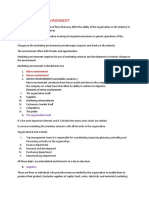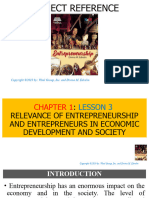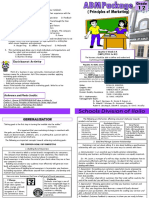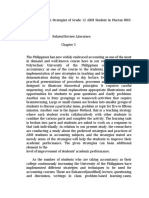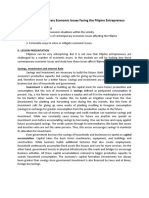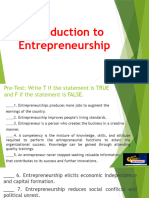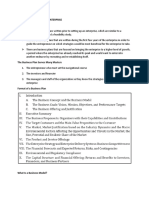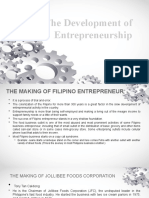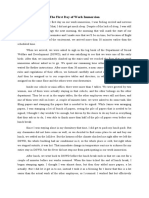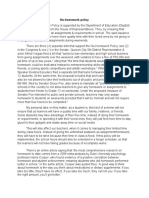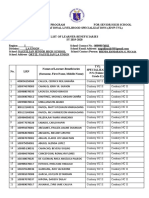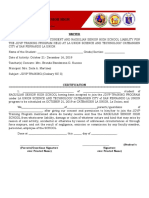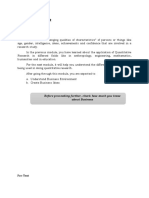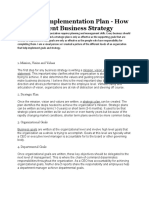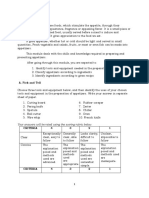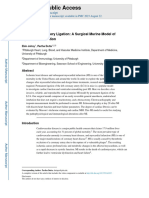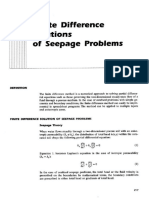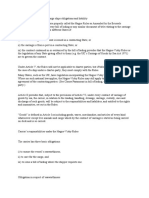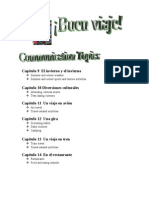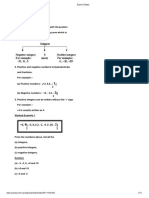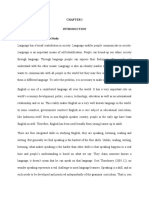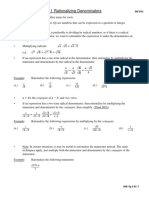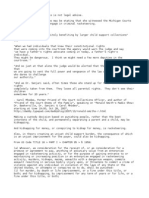REPUBLIC OF THE PHILIPPINES
DEPARTMENT OF EDUCATION
Region I
Division of La Union
NAGUILIAN SENIOR HIGH SCHOOL
P. Florendo St., Brgy. Ortiz, Naguilian, La Union
School ID: 340823
Email: naguilianSHS@gmail.com
0
ENTREPRENEURSHIP
QUARTER 1
MODULE 1
Target
1
�Entrepreneurship is the act of creating a business or businesses while building and
scaling it to generate a profit.
In this module, we shall define the basic concepts in entrepreneurship
and encourage you to develop your own understanding of entrepreneurial motivation.
The module also introduces the concept of small businesses and entrepreneurial
characteristics. You may have wondered why some people are able to see opportunities
and exploit them while others cannot perceive such opportunities. The module takes
you through the process of opportunity discovery, evaluation and exploitation and how
to bring goods and services to the market through design thinking and innovation. The
module further introduces you to the process of protecting your ideas through
intellectual property rights (IPR). Since entrepreneurship involves management of
small businesses, the module takes you through the business planning process
starting with ideation through validation, market identification, creation of the
entrepreneurial management teams, production of products and services to seeking of
business finance.
After going through this module, you are expected to:
1. Define Entrepreneurial competencies.
2. Explore the different Entrepreneurial core competencies
3. Describe the factors that affect the entrepreneurial decision making-process.
4. Explain the concept of entrepreneurship.
5. Distinguish between small businesses and entrepreneurial ventures.
Before proceeding further, check how much you know about
Entrepreneurship. Answer the pre-test in a separate sheet.
Pre-test. Direction: Choose the letter of the answer of your choice. Place it in the
blank provided before each number.
___ 1. Which personal characteristics of successful entrepreneurs reflects that
successful entrepreneur’s risk?
1
� a. Persistent
b. Inquisitive
c. Self confidence
d. Creative
___ 2. Which personal characteristics of successful entrepreneurs reflects that
successful develop a plan of action and make decision to help achieve that plan?
a. Risk-Takers
b. Goal-oriented
c. Independent
d. Self-Confident
___ 3. Emma and Ivy are considering beginning a jewelry-making business. They have
been collecting, reviewing, and interpreting the surveys they distributed last week
about their business idea. Emma and Ivy are in what stage of the entrepreneurial
process?
a. Discovery
b. Harvesting
c. Actualization
d. Concept development
___ 4. This is the process of designing, launching, and running a new business, which
is often initially a small business?
a. Entrepreneurship
b. Corporation
c. Cooperative
d. Banking
___ 5. Which of the following statements is true about new venture risk-taking:
a. When an entrepreneur seeks a high profit, the risk is usually higher.
b. When the entrepreneur seeks to limit risk, the reward tends to increase.
c. An entrepreneur's financial risk is not closely related to rewards.
d. The entrepreneur who does not care about profit is a high risk-taker.
___ 6. What kind of entrepreneurial competencies that related to recognizing and
developing market opportunities through various means?
a. Relationship competency
b. Conceptual competency
c. Opportunity competencies
d. Strategic competencies
___ 7. Which of the following is a type of intangible business property that is protected
by law:
a. Acreage
b. Inventory
2
� c. Trademark
d. Equipment
___ 8. Basic torts relating to businesses often involve disputes concerning
A. Emotional stress.
B. Assaults.
C. Defamation.
D. Contracts
___ 9. Describe the kind of factor that affected decision making in the situation given.
Cardo immediately rejected the offer of a new supplier because he knew that the
supply manager was a longtime rival.
a. Use of intuition
b. Attribution style
c. Over confidence
d. Counterfactual thinking
___ 10. Which personal characteristics of successful entrepreneurs reflects highly
innovative to generate new ideas to gain more profit?
a. Risks-taker
b. Innovation
c. Open-minded
d. Flexible
Module 1 Planning the Enterprise
3
�Jump Start
For you to understand the lesson well, do the following activities.
Have fun learning and good luck!
Activity 1: Ideas about Entrepreneurship
My ideas
Before beginning these activities, write down what you think ‘entrepreneurship’ means
to you.
_____________________________________________________________________________________
_____________________________________________________________________________________
_____________________________________________________________________________________
_____________________________________________________________________________________
_____________________________________________________________________________________
_____________________________________________________________________________________
_____________________________________________________________________________________
_____________________________________________________________________________________
_____________________________________________________________________________________
Activity 2: WHO ARE ENTREPRENEURS?
Direction: Start a list of people that you think are entrepreneurs and add to it as you
go through these activities.
Name of Entrepreneur What they did? Who benefits?
4
�Discover
WHICH ONE WILL YOU HIRE FOR A JOB?
“A PERSON WITH A GREAT SKILL OR A PERSON WITH A CHARACTER”
What is Entrepreneurship?
The concept of entrepreneurship
Entrepreneurship is a multidisciplinary concept, its meaning and use varies. It
has variously defined as the process of starting a new business venture through
identifying opportunities and acting on them. It can also defined as the process of
taking risks by pursuing a business venture with the aim of making profits. Others
think entrepreneurship is the creation of new enterprises. Another stream of thought
defines entrepreneurship as the process of creating new and unique combinations of
factors of production to produce economic growth. Entrepreneurship is the ability and
readiness to develop, organize and run a business enterprise, along with any of its
uncertainties in order to make a profit. The most prominent example of
entrepreneurship is the starting of new businesses. As you can see, the term seems to
have some definitional problems but there are commonalities that underlie these
definitions.
The term entrepreneur generally refers to an individual who can identify
various products or services, which people need and deliver these at the right time and
place at the right price. His/her activity called Entrepreneurship.
A. CORE COMPETENCIES
Entrepreneurial Competencies- the sum total of the personality, skills, and
knowledge that the entrepreneur possesses which are necessary to effectively perform
their functions and responsibilities.
Functional Competencies- a skills organized into clusters regarding, the main areas
of managerial knowledge
Emotional Competencies- are those specific behavior desired for the effective
performance of the entrepreneurial duties.
B. Six areas of Entrepreneurial Competencies
1. Opportunity competency- related to recognizing and developing market
opportunities through various means.
2. Relationship competency- related to a person-to-person or individual too
grouped based interaction.
3. Conceptual competency- related to different conceptual abilities which are
reflected in the behaviors of the entrepreneur
4. Organizing competency- related to the organization of different internal and
external human, physical, financial and technological resources, including team
building, leading employees, training and controlling.
5
� 5. Strategic competency- related to setting, evaluating and implementing the
strategies of the firm.
6. Commitment competency- competencies that drive the entrepreneur to move
ahead with the business.
C. Factors that affect the entrepreneurial Decision-making process
1. Use of intuition- this pertains to the use of “gut-feel” to arrive at a decision
2. Affect infusion- this suggest that the entrepreneurs, current moods influence
judgements or decisions by influencing the ease with which information
consistent with positive or negative moods can bought in mind.
3. Attribution style- refers to the entrepreneurs’ self-serving bias.
4. Counterfactual thinking- tendency to create possible alternatives to life events
that have already occurred, something that is contrary to what actually
happened,
5. Over-confidence- this refers to the tendency of the entrepreneurs to think that
they really know when they make a decision.
6. Knowing style- this is a combination of analytical and conceptual thinking,
where the entrepreneurs look for facts and data before they make decision.
7. Creative style- this characterized by holistic and conceptualized thinking,
entrepreneurs who uses this style tends to be creative and enjoy
experimentation before making decision.
D. Four Types of Entrepreneurship
Small Business Entrepreneurship-
These businesses are a hairdresser, grocery store, travel agent, consultant, carpenter,
plumber, electrician, etc. These people run or own their own business and hire family
members or local employee. For them, the profit would be able to feed their family and
not making 100 million business or taking over an industry. They fund their business
by taking small business loans or loans from friends and family.
Scalable Startup Entrepreneurship-
This start-up entrepreneur starts a business knowing that their vision can change the
world. They attract investors who think and encourage people who think out of the
box. The research focuses on a scalable business and experimental models, so, they
hire the best and the brightest employees. They require more venture capital to fuel
and back their project or business.
Large Company Entrepreneurship-
These huge companies have defined life cycle. Most of these companies grow and
sustain by offering new and innovative products that revolve around their main
products. The change in technology, customer preferences, new competition, etc.,
build pressure for large companies to create an innovative product and sell it to the
new set of customers in the new market. To cope with the rapid technological changes,
the existing organizations either buy innovation enterprises or attempt to construct
the product internally.
Social Entrepreneurship-
6
�This type of entrepreneurship focuses on producing product and services that resolve
social needs and problems. Their only motto and goal is to work for society and not
make any profits.
E. Characteristics of Entrepreneurship:
Not all entrepreneurs are successful; there are definite characteristics that make
entrepreneurship successful. A few of them mentioned below:
Ability to take a risk- Starting any new venture involves a considerable
amount of failure risk. Therefore, an entrepreneur needs to be courageous and
able to evaluate and take risks, which is an essential part of being an
entrepreneur.
Innovation- It should be highly innovative to generate new ideas, start a
company and earn profits out of it. Change can be the launching of a new
product that is new to the market or a process that does the same thing but in
a more efficient and economical way.
Visionary and Leadership quality- To be successful, the entrepreneur should
have a clear vision of his new venture. However, to turn the idea into reality, a
lot of resources and employees are required. Here, leadership quality is
paramount because leaders impart and guide their employees towards the right
path of success.
Open-Minded- In a business, every circumstance can be an opportunity and
used for the benefit of a company. For example, Paytm recognized the gravity of
demonetization and acknowledged the need for online transactions would be
more, so it utilized the situation and expanded massively during this time.
Flexible- An entrepreneur should be flexible and open to change according to
the situation. To be on the top, a businessperson should be equipped to
embrace change in a product and service, as and when needed.
Know your Product-A company owner should know the product offerings and
be aware of the latest trend in the market. It is essential to know if the available
product or service meets the demands of the current market, or whether it is
time to tweak it a little. Being able to be accountable and then alter as needed
is a vital part of entrepreneurship.
F. Importance of Entrepreneurship:
Creation of Employment- Entrepreneurship generates employment. It
provides an entry-level job, required for gaining experience and training for
unskilled workers.
Innovation- It is the hub of innovation that provides new product ventures,
market, technology and quality of goods, etc., and increase the standard of
living of people.
Impact on Society and Community Development- A society becomes greater
if the employment base is large and diversified. It brings about changes in
society and promotes facilities like higher expenditure on education, better
sanitation, fewer slums, a higher level of homeownership. Therefore,
7
� entrepreneurship assists the organisation towards a more stable and high
quality of community life.
Increase Standard of Living- Entrepreneurship helps to improve the standard
of living of a person by increasing the income. The standard of living means,
increase in the consumption of various goods and services by a household for a
particular period.
Supports research and development- New products and services need to be
research and tested before launching in the market. Therefore, an entrepreneur
also dispenses finance for research and development with research institutions
and universities. This promotes research, general construction, and
development in the economy.
Explore
Enrichment Activity 1: Entrepreneur mind map.
What do you think to be an entrepreneur? What do you think are some of the
characteristics of an entrepreneur? Make a mind map of your idea using graphic
organizer.
Entrepreneur
Enrichment Activity 2: WHAT IS AN ENTREPRENEUR?
DEFINING ENTREPRENEURS
8
�There are many different definitions of an Entrepreneur.
a. Entrepreneurship is the process of designing, launching, and running a
new business which is often initially a small business. The people who
create these businesses are called entrepreneurs. Wikipedia
b. One who organizes and manages any enterprise, esp one involving
considerable risk. Macquarie Dictionary
c. A person who sets up a business or businesses, taking on financial risks
in the hope of profit. Oxford Dictionary
d. Someone who undertakes a significant project or activity finding new or
better ways of doing things; they are opportunity-aware, take risks and
utilize a range of behaviors, such as initiative and innovation, that create
value and contribute to their success. Australian Curriculum, ACARA
Question 1. What do these definitions have in common?
_____________________________________________________________________________________
_____________________________________________________________________________________
_____________________________________________________________________________________
_____________________________________________________________________________________
_____________________________________________________________________________________
_____________________________________________________________________________________
_____________________________________________________________________________________
_____________________________________________________________________________________
Enrichment Activity 3: Read and analyze the situation below describe the factor
that affected decision-making.
1. Cardo immediately rejected the offer of a new supplier because he knew that the
supply manager was a longtime rival.
2. Aliana decided to sell her company’s computer system because she think this is
causing the poor performance of her company.
3. Teddy decided not yet to pursue the poultry business because he first wanted to
see valid information or data if this type of business would succeed or not.
4. Flora has witnessed how her product’s sales declined in the pass due to the
change in price. Now she wanted to know if the sales would boost this time by
preparing three different product strategies.
Enrichment Activity 4:
9
� 1. Using a table with two columns, distinguish the difference between small
business entrepreneur and large company entrepreneur.
Small business entrepreneur Large company entrepreneur
Deepen
Direction: Explain briefly
If you will give, a change to have 1M share your vision as a young entrepreneur.
_____________________________________________________________________________________
_____________________________________________________________________________________
_____________________________________________________________________________________
_____________________________________________________________________________________
_____________________________________________________________________________________
_____________________________________________________________________________________
_____________________________________________________________________________________
_____________________________________________________________________________________
Gauge
10
�1. Which personal characteristics of successful entrepreneurs reflects that successful
entrepreneur’s risk?
a. Persistent
b. Inquisitive
c. Self confidence
d. Creative
___ 2. Which personal characteristics of successful entrepreneurs reflects that
successful develop a plan of action and make decision to help achieve that plan?
a. Risk-Takers
b. Goal-oriented
c. Independent
d. Self-Confident
___ 3. Emma and Ivy are considering beginning a jewelry-making business. They have
been collecting, reviewing, and interpreting the surveys they distributed last week
about their business idea. Emma and Ivy are in what stage of the entrepreneurial
process?
a. Discovery
b. Harvesting
c. Actualization
d. Concept development
___ 4. This is the process of designing, launching, and running a new business, which
is often initially a small business?
a. Entrepreneurship
b. Corporation
c. Cooperative
d. Banking
___ 5. Which of the following statements is true about new venture risk-taking:
a. When an entrepreneur seeks a high profit, the risk is usually higher.
b. When the entrepreneur seeks to limit risk, the reward tends to increase.
c. An entrepreneur's financial risk is not closely related to rewards.
d. The entrepreneur who does not care about profit is a high risk-taker.
___ 6. What kind of entrepreneurial competencies that related to recognizing and
developing market opportunities through various means?
a. Relationship competency
b. Conceptual competency
c. Opportunity competencies
d. Strategic competencies
___ 7. Which of the following is a type of intangible business property that is protected
by law:
11
� a. Acreage
b. Inventory
c. Trademark
d. Equipment
___ 8. Basic torts relating to businesses often involve disputes concerning
a. Emotional stress.
b. Assaults.
c. Defamation
d. Contracts
___ 9. Describe the kind of factor that affected decision making in the situation given.
Cardo immediately rejected the offer of a new supplier because he knew that the
supply manager was a longtime rival.
a. Use of intuition
b. Attribution style
c. Over confidence
d. Counterfactual thinking
___ 10. Which personal characteristics of successful entrepreneurs reflects highly
innovative to generate new ideas to gain more profit?
a. Risks-taker
b. Innovation
c. Open-minded
d. Flexible
Module 1 Key Answers
Pre-test. Direction: Choose the letter of the answer of your choice. Place it in the
blank provided before each number.
12
�A1. Which personal characteristics of successful entrepreneurs reflects that successful
entrepreneur’s risk?
a. Persistent
b. Inquisitive
c. Self confidence
d. Creative
A2. Which personal characteristics of successful entrepreneurs reflects that successful
develop a plan of action and make decision to help achieve that plan?
a. Risk-Takers
b. Goal-oriented
c. Independent
d. Self-Confident
D3. Emma and Ivy are considering beginning a jewelry-making business. They have
been collecting, reviewing, and interpreting the surveys they distributed last week
about their business idea. Emma and Ivy are in what stage of the entrepreneurial
process?
a. Discovery
b. Harvesting
c. Actualization
d. Concept development
A4. This is the process of designing, launching, and running a new business, which is
often initially a small business?
a. Entrepreneurship
b. Corporation
c. Cooperative
d. Banking
A 5. Which of the following statements is true about new venture risk-taking:
a. When an entrepreneur seeks a high profit, the risk is usually higher.
b. When the entrepreneur seeks to limit risk, the reward tends to increase.
c. An entrepreneur's financial risk is not closely related to rewards.
d. The entrepreneur who does not care about profit is a high risk-taker.
C6. What kind of entrepreneurial competencies that related to recognizing and
developing market opportunities through various means?
a. Relationship competency
b. Conceptual competency
c. Opportunity competencies
d. Strategic competencies
C7. Which of the following is a type of intangible business property that protected by
law:
13
� a. Acreage
b. Inventory
c. Trademark
d. Equipment
D8. Basic torts relating to businesses often involve disputes concerning
a. Emotional stress.
b. Assaults.
c. Defamation
d. Contracts
A9. Describe the kind of factor that affected decision making in the situation given.
Cardo immediately rejected the offer of a new supplier because he knew that the
supply manager was a longtime rival.
a. Affect infusion
b. Attribution style
c. Over confidence
d. Counterfactual thinking
B10. Which personal characteristics of successful entrepreneurs reflects highly
innovative to generate new ideas to gain more profit?
a. Risks-taker
b. Innovation
c. Open-minded
d. Flexible
Jump Start
Activity 1: Ideas about Entrepreneurship (answer may vary depending on
students understanding)
My ideas
Before beginning these activities, write down what you think ‘entrepreneurship’ means
to you.
Activity 2: WHO ARE ENTREPRENEURS?
14
�Direction: Start a list of people that you think are entrepreneurs and add to it as you
go through these activities. (answer may vary)
Name of Entrepreneur What they did? Who benefits?
Catherine Ball A drone specialist and Everyone
founder of five start-up
companies.
Liz Williams and Kate Scientists and inventors Deaf person
Lomas whose invention is helping
the profoundly deaf.
Pia Winberg A marine ecologist with a Farmers
start-up business in
seaweed farming.
Enrichment Activity 1: Entrepreneur mind map.
What do you think to be an entrepreneur? What do you think are some of the
characteristics of an entrepreneur? Make a mind map of your idea using graphic
organizer. (Answer may vary)
Innovative
Smart Risks
taker
Entrepreneur
Persistent Flexible
Attentive
15
� Enrichment Activity 2: WHAT IS AN ENTREPRENEUR?
DEFINING ENTREPRENEURS
There are many different definitions of an Entrepreneur.
a. Entrepreneurship is the process of designing, launching, and running a
new business, which is often initially a small business. The people who
create these businesses called entrepreneurs. Wikipedia
b. One who organizes and manages any enterprise, esp one involving
considerable risk. Macquarie Dictionary
c. A person who sets up a business or businesses, taking on financial risks
in the hope of profit. Oxford Dictionary
d. Someone who undertakes a significant project or activity finding new or
better ways of doing things; they are opportunity-aware, take risks and
utilize a range of behaviors, such as initiative and innovation, that create
value and contribute to their success. Australian Curriculum, ACARA
Question 1. What do these definitions have in common? (Answers may vary)
Use the rubrics below in rating students’ responses.
3 2 1 0
Exceeded Satisfactorily Met Came close to Did not meet the
expectations all expectations meeting the expectations
expectations
DETAILS/ Provides a VERY Provides a Came close to Did not meet the
CONTENT OF thorough and clear thorough and clear meeting the expectations and
ESSAY and concise and concise expectations but was missing
content content was missing one or crucial elements.
two minor Provides an
elements or unclear and
details. Provides a unintelligible
somewhat details
muddled and
rambling details
REFLECT Shows great depth Relates learning, Little reflection of Shows No evidence
PERSONAL of knowledge and reveals feelings learning, of learning or
THOUGHTS/ learning , reveals and abstract ideas generalizations reflection. No or
KNOWLEDG/ feelings and reflected through and limited few details to
LEARNING abstract ideas the use of specific insight, uses some support reflection
reflected through details detail
the use of specific Limited
details explanation
MECHANICS/ Consistently Contains accurate Contains Consistently
GRAMMAR contains accurate and proper numerous errors contains
and proper grammatical in grammatical inaccurate and
grammatical conventions, conventions, incorrect
conventions, spelling, and spelling, and grammatical
spelling, and punctuations punctuations conventions,
punctuations spelling, and
punctuations
16
�Enrichment Activity 3: Read and analyze the situation below describe the factor
that affected decision-making.
1. Cardo immediately rejected the offer of a new supplier because he knew that the
supply manager was a longtime rival. Affect infusion
2. Aliana decided to sell her company’s computer system because she think this is
causing the poor performance of her company. Attribution style
3. Teddy decided not yet to pursue the poultry business because he first wanted to see
valid information or data if this type of business would succeed or not. Knowing style
4. Flora has witnessed how her product’s sales declined in the pass due to the change
in price. Now she wanted to know if the sales would boost this time by preparing three
different product strategies. Counter factual
Enrichment Activity 4:
Using a table with two columns, distinguish the difference between small business
entrepreneur and large company entrepreneur. (Answer may vary)
Small business entrepreneur Large company entrepreneur
People run their own business Huge company
Hired family members Grow and sustain new innovative
product
Not intended for a big profit Intended for higher profit
Getting funds through loans Getting funds through organization
Deepen: Direction: Explain briefly
If you will give, a change to have 1M share your vision as a young entrepreneur.
Use the rubrics below in rating students’ responses.
3 2 1 0
17
� Exceeded Satisfactorily Met Came close to Did not meet the
expectations all expectations meeting the expectations
expectations
DETAILS/ Provides a VERY Provides a Came close to Did not meet the
CONTENT OF thorough and clear thorough and clear meeting the expectations and
ESSAY and concise and concise expectations but was missing
content content was missing one or crucial elements.
two minor Provides an
elements or unclear and
details. Provides a unintelligible
somewhat details
muddled and
rambling details
REFLECT Shows great depth Relates learning, Little reflection of Shows No evidence
PERSONAL of knowledge and reveals feelings learning, of learning or
THOUGHTS/ learning , reveals and abstract ideas generalizations reflection. No or
KNOWLEDG/ feelings and reflected through and limited few details to
LEARNING abstract ideas the use of specific insight, uses some support reflection
reflected through details detail
the use of specific Limited
details explanation
MECHANICS/ Consistently Contains accurate Contains Consistently
GRAMMAR contains accurate and proper numerous errors contains
and proper grammatical in grammatical inaccurate and
grammatical conventions, conventions, incorrect
conventions, spelling, and spelling, and grammatical
spelling, and punctuations punctuations conventions,
punctuations spelling, and
punctuations
18
�19

